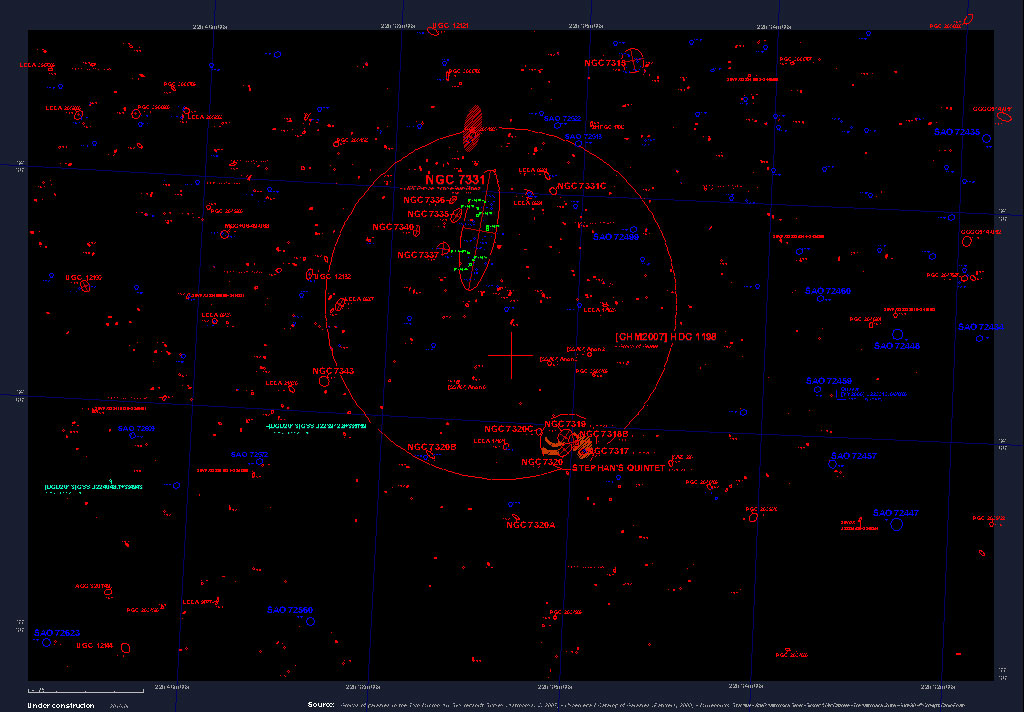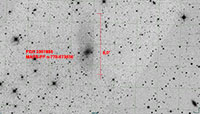 |
||||
| Al di la della Luna; Beyond the Moon; Astrophotography; Astrofotografia; Danilo Pivato | ||||
|
||||
 |
|||
Photo: Danilo Pivato © Copyright: - Images & texts 2016 - All rights reserved |
|||
The Analysis of Frame |
|||
NGC 7331; UGC 12113; Caldwell 30; MCG+06-49-045; LEDA 69327; H I-53; h 2172; GC 4815; CGCG 514.068: LINER-type Active Galaxy Nucleus - [field: 3,4° x 5,1°] |
|||
NGC 7331 Region: Galaxy in Pegasus: RAJ2000.0 22h37m04.102s - Dec J2000.0 +34°24'57.31" [SIMBAD] - Estesa galassia a spirale che primeggia nell'inquadratura insieme al famoso Stephan's Quintet e al grande Group of Galaxies [CHM2007] HDC 1198. NGC 7331 stranamente è una delle galassie luminose non incluse nel catalogo di Messier, presenta infatti una magnitudine (v) 9.48^ [SIMBAD] ed un'estensione fotografica equivalente a circa 13' x 5'. L'aspetto morfologico è stato classificato di tipo: SA (s) b D [SIMBAD]. Ad est della galassia ci sono altre quattro galassie minori considerate satelliti di NGC 7331 tutte di magnitudine superiore alla 14^; a partire da quella più settentrionale esse sono: NGC 7336; NGC 7335; NGC 7340 e NGC 7337. Scoperta da William Herschel nel 1784, mentre nel 1850 Lord Rosse nel suo elenco delle 14 "Spiral or curvilinear nebulae", ne intuì la vera natura. La galassia presenta un'inclinazione di 17° e il bordo ad Est è quello rivolto verso la nostra direzione, come si può dedurre (specialmente osservando le immagini a scala maggiore), dalla maggiore abbondanza di polveri presenti su quel lato. Dopo uno studio condotto da V. C. Rubin, E. M. & G. R. Burbidge, D. J. Crampin e K. H. Prendergast (1964) essi descrivono e trovano per la prima volta la galassia NGC 7331 molto simile come tipo e struttura alla Grande Galassia di Andromeda M31 ma 23 volte più distante. Attualmente le ultime stime sulla distanza si approssimano intorno ai 45 milioni di anni luce. Per quanto è dato sapere soltanto tre supernovae sono state scoperte in NGC 7331: la prima SN 1959D, fu scoperta da Humason a 32" W e 13" N dal nucleo della galassia. La supernova giunse sino alla 13,4^ magnitudine (IAUC 1682). Scoperta da Koichi Itagaki il 21 aprile del 2013 è la seconda supernova: SN 2013BU localizzata a 25" W e 52" S dal nucleo di NGC 7331, raggiunse la 15,9^ magnitudine [CBET 3498]. Ancora più recentemente nel 2014 è stata invece scoperta la terza supernova (SN 2014C) in NGC 7331 ad opera di Kim Zheng et al. del Lick Observatory Supernova Search (USA) a 19".7 E e 24".2 S dal centro della galassia. La scoperta risale al 5 gennaio quando fu stimata di 18.0^ magnitudine, raggiunse la massima luminosità di 15,5^ magnitudine [CBET 3777]. (... Continua) NGC 7325: RAJ2000.0 22h36m33.5s - Dec J2000.0 +34°30'05" [SIMBAD] - Galassia di mag. B 16,6^; V 16.1^ [SIMBAD] - E' questo un oggetto che nel corso della storia anche recente ha presentato diverse controversie, sia nell'attribuzione del nome e sia di posizione. Per quanto ci è dato sapere anche i successivi oggetti del New General Catalogue ovvero: NGC 7326 e NGC 7327, tutti disposti nei dintorni, soprattutto nei pressi del lato occidentale della galassia NGC 7331, hanno subito alterne vicende di classificazione. NGC 7325 fu scoperto da Magnus Herman Schultz nel 1865 con un rifrattore da 9,6", il quale secondo la sintetica simbologia tipica del catalogo di appartenenza lo descrisse quale: F, vS, h 2172 f. Nel "The Revised New General Catalogue of NonStellar Astronomical Objects" RNGC di J. W. Sulentic & W. G. Tifft del 1977, NGC 7325 viene descritta con la seguente nuova descrizione: R, Almstel, Hisb = Round, Almost Stellar, High Surface Brightness, senza alcuna nota sulla magnitudine. Secondo H. G. Corwin Jr. (Infrared Processing and Analysis Center - Caltech - California), questa galassia è invece una stella doppia molto stretta poco più a Nord della posizione rivelata da Herman Schultz. NGC 7326: RAJ2000.0 22h36m22.764s - Dec J2000.0 +34°32'36.93" [SIMBAD - Galassia di mag. B 15,7^ - tipo morfologico 3 D con dimensioni angolari di 0.933' x 0.485' (nella banda infrarossa) [SIMBAD] NGC 7327: RAJ2000.0 --h--m--.-s - Dec J2000.0 +--°--'--" [SIMBAD] Oggetto inesistente [SIMBAD]. Il NED invece di quest'oggetto fornisce coordinate: RAJ2000.0 22h36m34.0s - Dec J2000.0 +34°30'13" [NED] ed è individuato come Galassia. Le notizie storiche a riguardo ci riportano la scoperta ad opera di Ernst Wilhelm Leberecht Tempel nel 1882 tramite l'impiego di un rifrattore da 11". La sommaria descrizione offerta nel New General Catalogue e, a quanto sembra, con il mancato riporto delle coordinate da parte dello scopritore, non hanno mai aiutato a definirne e quindi ad identificare con certezze, l'oggetto classificato come NGC 7327. NGC 7335: RAJ2000.0 22h37m19.358s - Dec J2000.0 +34°26'52.54" [SIMBAD] di magnitudine 14,3^ è la più cospicua delle galassie satelliti di NGC7331 nell'immagine sopra riprodotta mostra evidente l'aspetto extrastellare. NGC 7336: RAJ2000.0 22h37m21.863s - Dec J2000.0 +34°28'54.55" [SIMBAD] NGC 7337: RAJ2000.0 22h37m26.631s - Dec J2000.0 +34°22'27.54" [SIMBAD] NGC 7340: RAJ2000.0 22h37m44.238s - Dec J2000.0 +34°24'36.27" [SIMBAD] NGC 7343; LEDA 69391; UGC 12129; MCG+06-49-059; SDSS J223837.86+340417.4: RAJ2000.0 22h38m37.866s - Dec J2000.0 +34°04'17.00" [SIMBAD] - Bellissima galassia a spirale di aspetto morfologico tipo SBb D con due ampi bracci che, nell'aspetto, ricordano molto M100, opportunamente ruotata. Nel 1974 in corrispondenza del braccio meridionale esplose una supernova (SN1974J) di tipo Ia, raggiunse la 16^ magnitudine. Fu scoperta da Leonida Rosino. UGC 12144; PGC 69462: RAJ2000.0 22h40m33.691s - Dec J2000.0 +33°27'58.97" [SIMBAD] - Magnitudini: 14.3^(R); 15.4^ (B); 12.5^ (J); 11.7^(H); 11.4^(K) - Galassia di tipo morfologico: SBb D, si presenta con dimensioni apparenti di 1.1'x0.8' , Angolo di Posizione = 120°. Nell'inquadratura si trova nei pressi dell'angolo basso a sinistra, purtroppo dove la qualità dell'immagine risulta più scadente. In ogni caso la galassia merita riprese più profonde e con strumenti maggiori, in quanto il suo aspetto è caratterizzato dalla presenza di due ampie braccia, molto sottili, rispettivamente a N e S che conferiscono una consueta e perfetta forma ad "S" tipica di questa classe di galassie. A poco meno di 2' in direzione SW si trova una stella rossa di magnitudine 11.6^(v).
|
|||
PGC 2051985: RAJ2000.0 22h37m12.44s - Dec J2000.0 +34°37'12.9" [LEDA] - Galassia situata a NNE e ad una distanza apparente pari a 12.5' dal nucleo di NGC 7331. Questa galassia presenta un angolo di posizione equivalente a 146° ed una magnitudine apparente pari a 16.8^ (B) e 15.7^ (r), mentre la magnitudine superficiale: mag/arcsec2 è di 24.58^ - La misura apparente della galassia effettuata direttamente sull'immagine del POSS" è: 56" x 29". La particolarità di cui se ne vuole fornire notizia, sta nell'aver individuato tramite forte stretching, sia sulle lastre (r) e (b) del DSS2 - POSS2UKSTU e sia per conferma sul pacchetto di lastre del UKIDSS a cui si rimanda facendo click sopra l'anteprima posta qui a lato della pagina, un debole quanto esteso sviluppo angolare apparente, equivalente in prima approssimazione a circa 6,0'! Fatta una breve ricerca su Internet non è stata trovata alcuna notizia specifica riguardo la galassia PGC 2051985, ne su articoli pubblicati sulle riviste professionali, ne su articoli di settore. Sul SIMBAD la galassia è chiamata: MAPS-PP O-778-973630 cifratura di un catalogo pubblicato nel 1997 basato sulla ricerca di galassie appartenenti al Superammasso Pisces-Perseus (PPS) realizzato attraverso la Minnesota Automated Plate Scanner Pisces-Perseus Survey (MAPS-PP). Il MAPS-PP è un catalogo composto da circa 1400 galassie realizzato attraverso le scansioni digitalizzate delle lastre blu e rosse del Palomar Observatory Sky Survey. La particolarità di questa debole estensione sembra in realtà, propagarsi con direzione divergente rispetto all'asse maggiore della galassia PGC 2051985. Se questo si sviluppa con direzione NO - SE, per contro la debole estensione ha invece direzione N-S. (... Continua) |
|||
UKIDSS - Image |
|||
Historical observations: "The Hubble Atlas of Galaxies", 1961, Washington, D.C. Carnegie Istitution of Washington" - "This galaxy, seen almost on edge, is of the NGC 2841, NGC 5055 type, though the spiral arms do not seem to be as thin and are more easily visible. The increased visibility of the arms may be an effect of projection, because the dust lanes and interspersed luminous arms are silhouetted against the bright background luminosity of the central regions of the galaxy. Spiral arms can be seen to within about 12 sec of arc (radius) of the center (about 6 mm on the scale of the illustration). This illustration does not show the detail in the central regions. The burned-out central region is not amorphous like the center of M31 or M81 but has a spiral structure like that in NGC 5055. Allan Sandage & John Bedke - 1994 - "Has a spiral pattern of the MAS type, similar to that of M31. However, the nuclear bulge is smaller than in M31, and the arms in NGC 7331 can be traced closer to the center than M31. NGC 7331 is superposed on a more-distant group of early-type galaxies with a mean redshift of about 6000 km s -1, of which Stephan's Quintet is a subgroup. Three galaxies of this more-distant group can be in the map here. As described in thr Hubble Atlas, NGC 7331 played a crucial role in settling an early problem as to the direction of the opening of the spiral pattern relative to the direction of rotation of the galaxy" [Allan Sandage & John Bedke - 1994]. Secondo il "The de Vaucouleurs Atlas of Galaxies, R.J. Buta, H.G. Cprwin, Jr, and S. C. Odewahn NGC 7331 "has complex, partly flocculent spiral structure and considerable nearside extinction. That the bulge is significant is evidence by the " fattening" of the galaxy's isophotes around the minor axis of the outer disk. In the center, a mini disk is seen that has an enhanced ridge on one side. In the B - I color index, this ridge is blue, suggesting the presence of a ring. Only half the ring may be seen because of the severe nearside extinction.
|
|||
Danilo Pivato © Copyright: -Text & Images 2016 - All rights reserved |
|||

